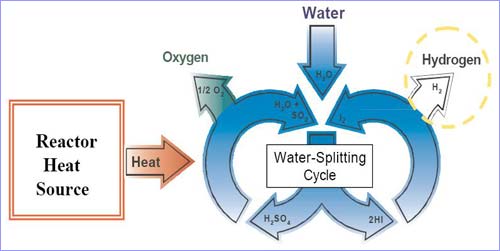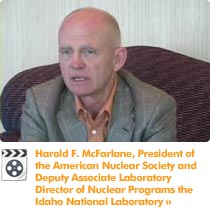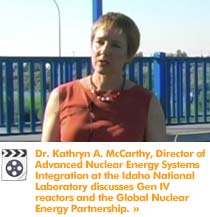

Research will continue, however, as there are still materials issues to deal with. “The materials problems are challenging,” says Herring. “Particularly this inner-connect plate, which is a ferritic stainless steel. In our 900-degree test it seemed to corrode a lot faster at 900 than it did at 850. Right now, our happy medium for all the different forces seems to be about 830 Celsius, Herring explains.
“It’s glowing red-hot when it’s operating, but we don’t want to use platinum, and we don’t want to use inherently scarce materials. We want to be able to work with the materials that have been developed by the solid oxide fuel cell program -- the SECA program -- and to make use of that research. We don’t want to reinvent wheel,” Herring reminds.
Thermo-chemical Production
Further out is thermochemical production of hydrogen. While this process is still under investigation -- with experiments ongoing in at least three different countries -- engineers feel that this avenue has sufficient potential to merit continued research. General Atomics is also very much involved in the development of this water splitting process, as the company’s Dr. Kenneth Schultz explains.
“We identified the sulfur-iodine cycle as the one best suited for hydrogen production from a nuclear heat source,” says Schultz, operations director for General Atomics’ Energy Group. “It has the highest efficiency among the thermochemical cycles and is easier in handling because all of the steps are liquids or gasses -- no solids,” he explains, adding, “France and Japan, through their own processes of screening and evaluation, also selected the sulfur-iodine cycle as their leading candidate.”

The sulfur-iodine process -- all of the chemicals used are returned and are recycled within the process. High-temperature heat and water are the only inputs, while low-temperature heat, hydrogen and oxygen are the byproducts.
Chosen from 115 unique thermochemical cycles, the sulfur-iodine water-splitting process is also a developing technology. And although it is not currently available, General Atomics and others, both here and abroad, are researching the various steps within process.
“Thermochemical water-splitting was explored extensively the last time there was a lot of excitement about hydrogen, which was in the 1970s,” Schultz recalls. “The challenge here is that it does require high temperatures and the reagents -- iodine and sulfur dioxide -- are corrosive materials even at low temperatures. At high temperature they’re really corrosive,” Schultz reminds.
Entire contents © 2006 Corland Publishing. Use of editorial content without permission is strictly prohibited.
All Rights Reserved. Privacy Policy Legal Contact Us. Site developed by ICON.




